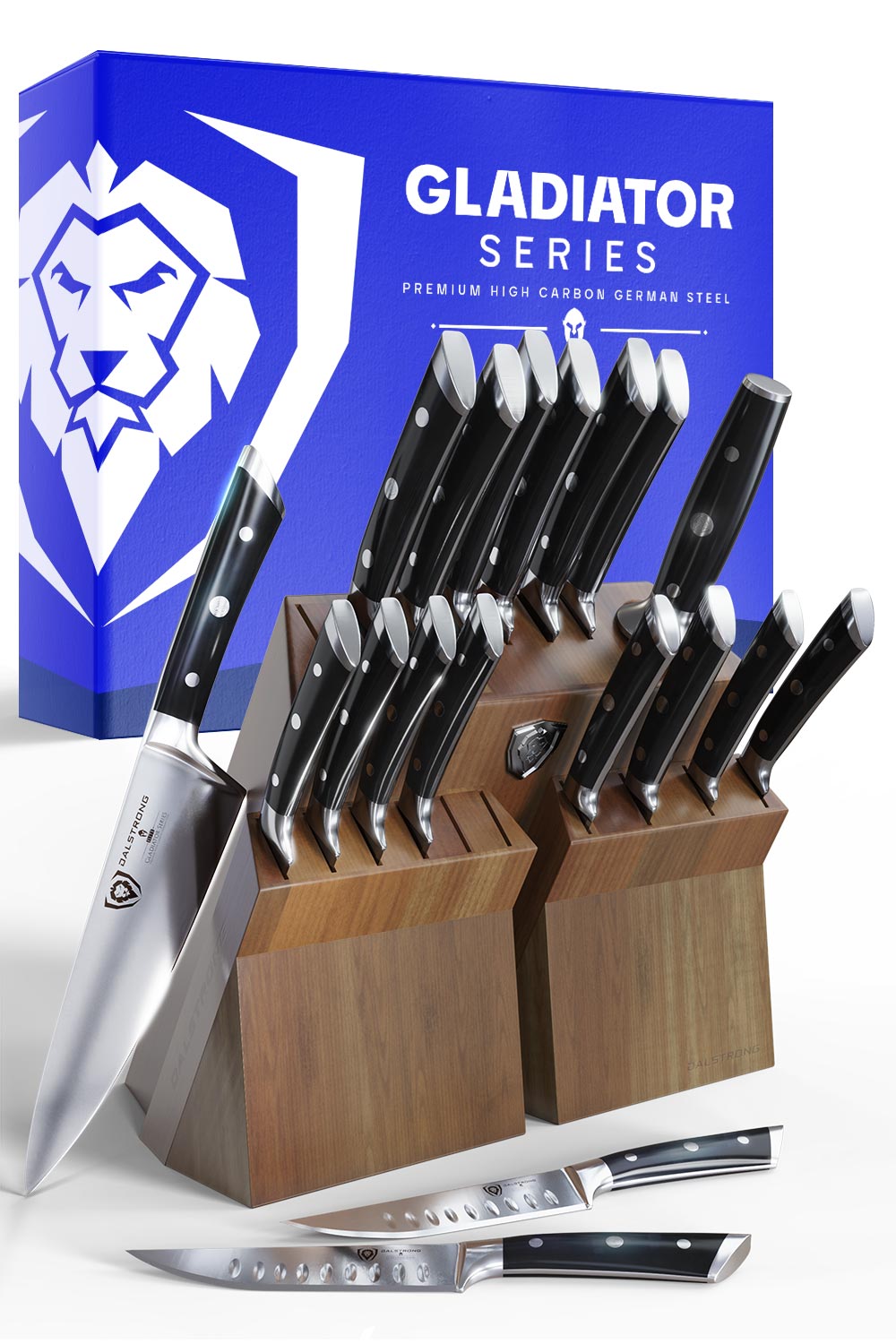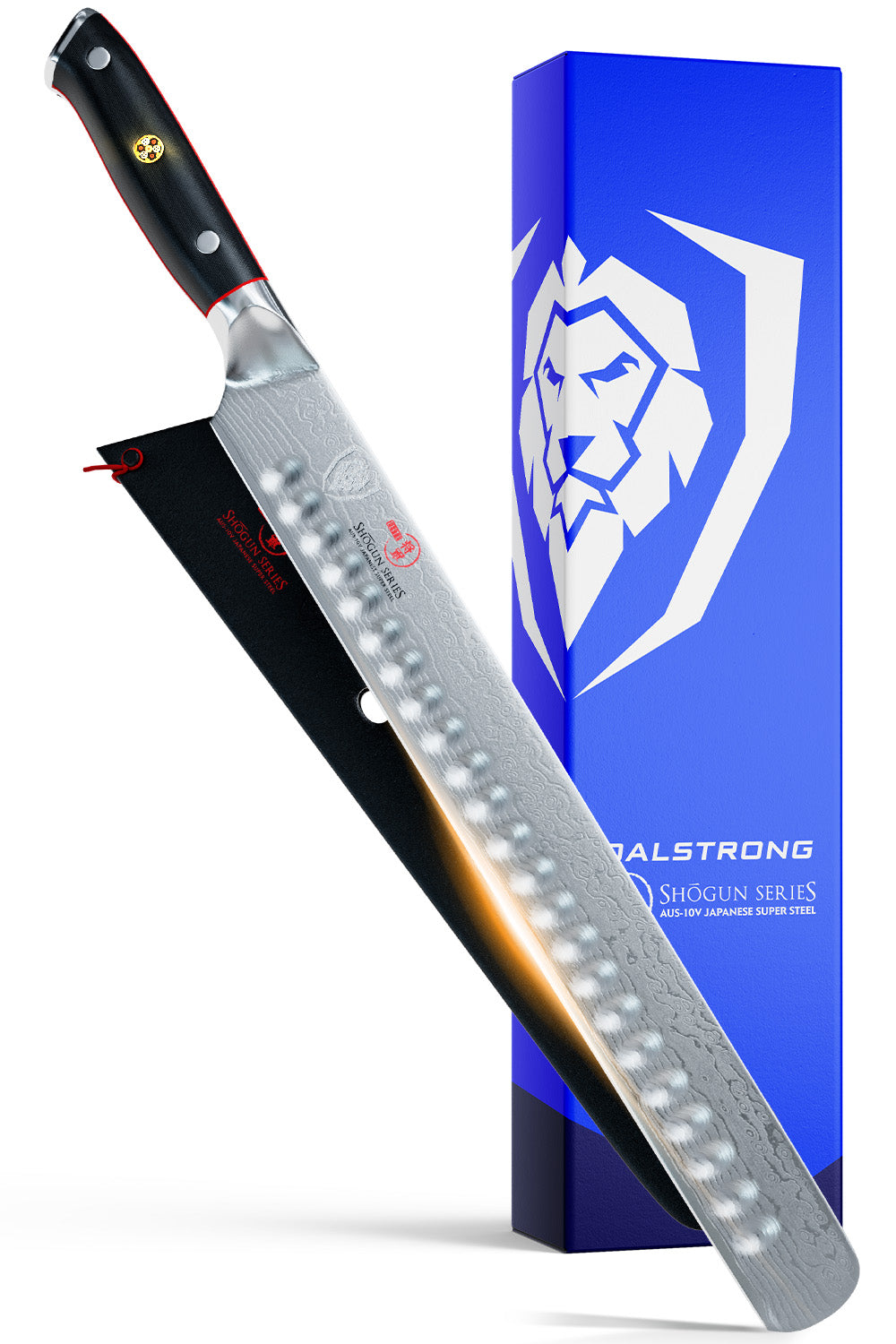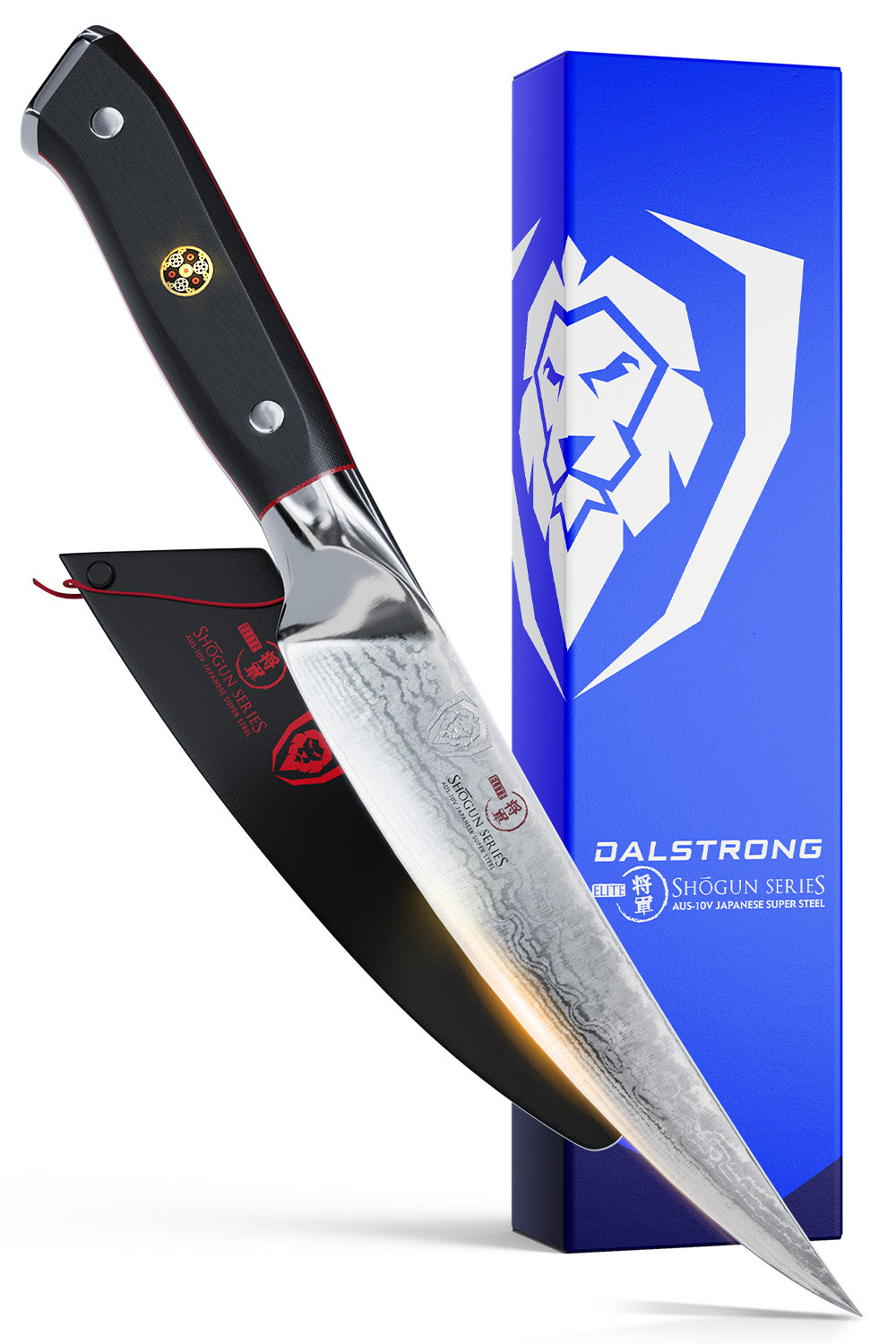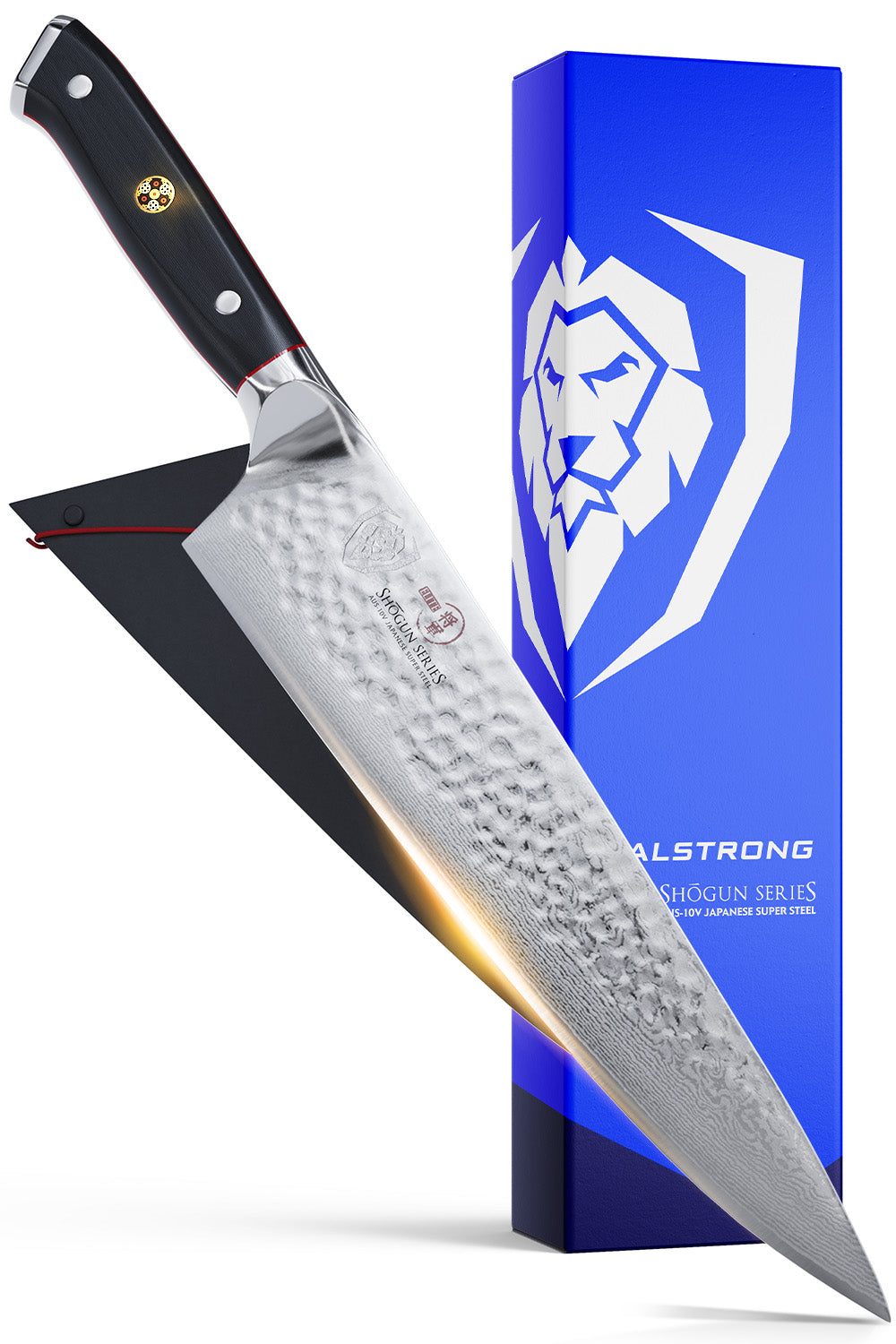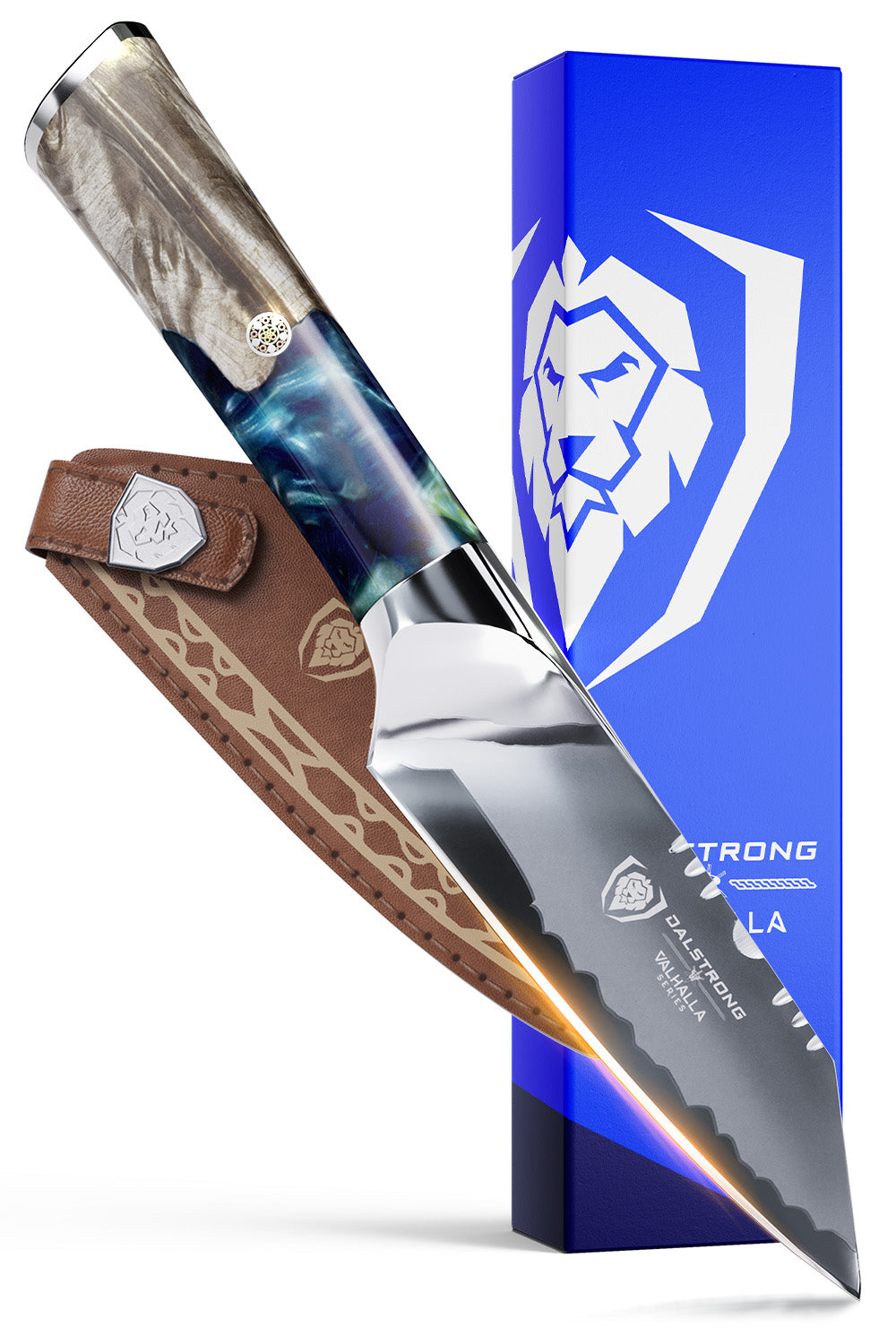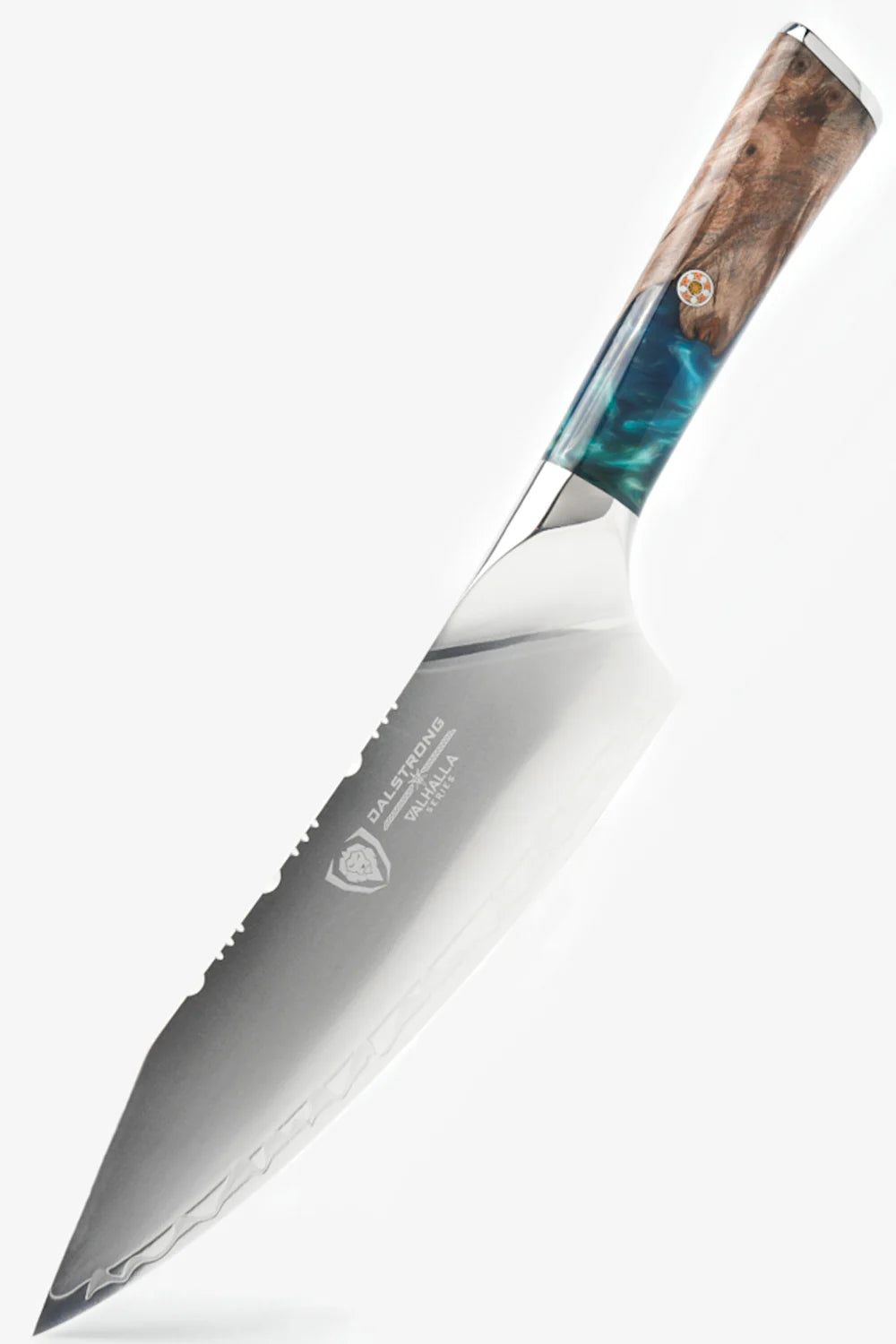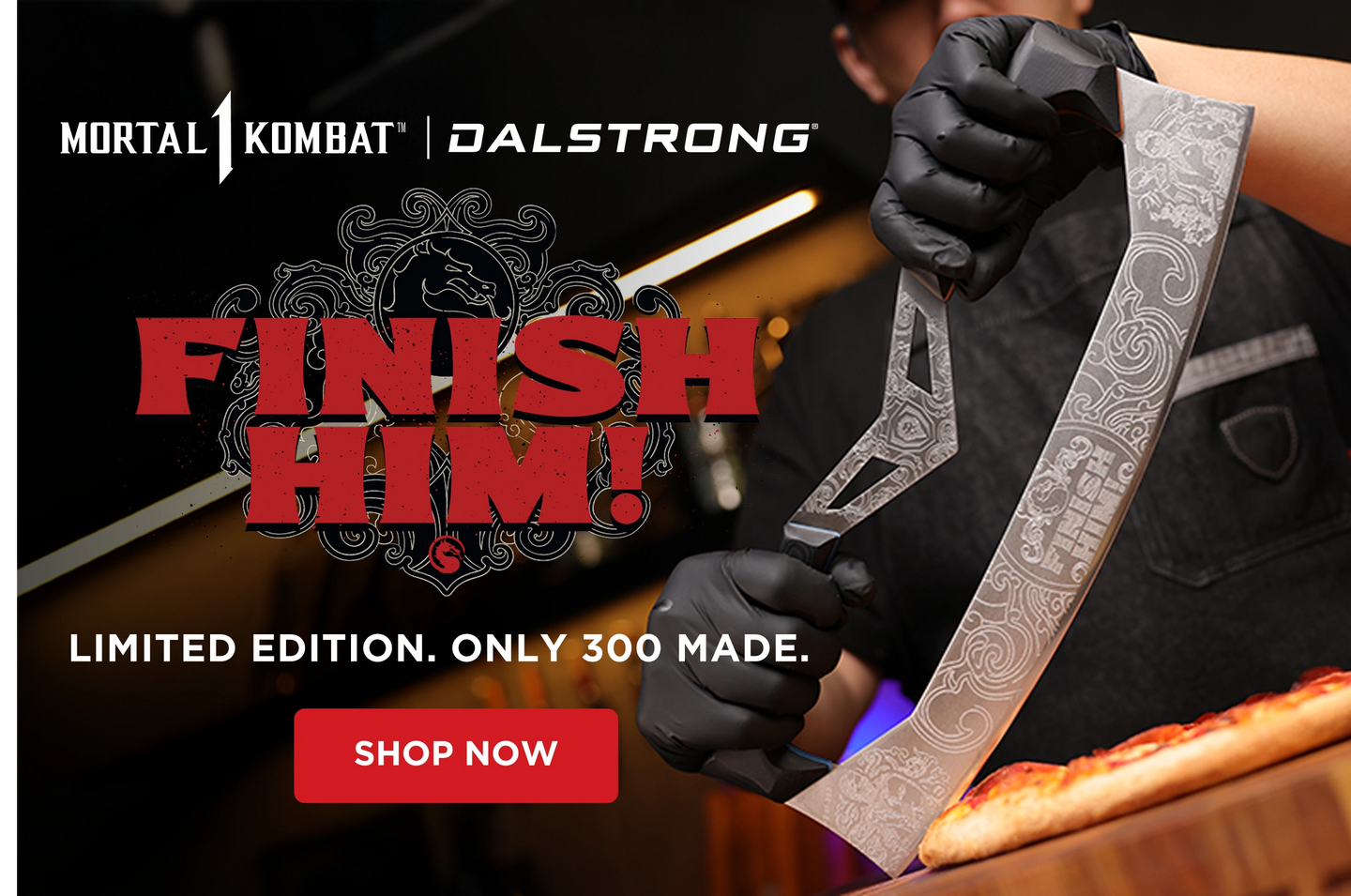 Teak Wooden Cutting Board | Dalstrong ©
Teak Wooden Cutting Board | Dalstrong ©
Not to state the obvious, but cutting boards are just as important as your favorite knives, aprons, stock pots, and skillets! I too, thought that they were a tiny addition to kitchen essentials, but I changed my mind after purchasing a few of Dalstrong’s cutting boards.
This article is a detailed guide to owning and knowing your cutting board, learning how to take care of it, and some of Dalstrong’s best cutting boards. Folks, it’s time to invest in a large cutting board.
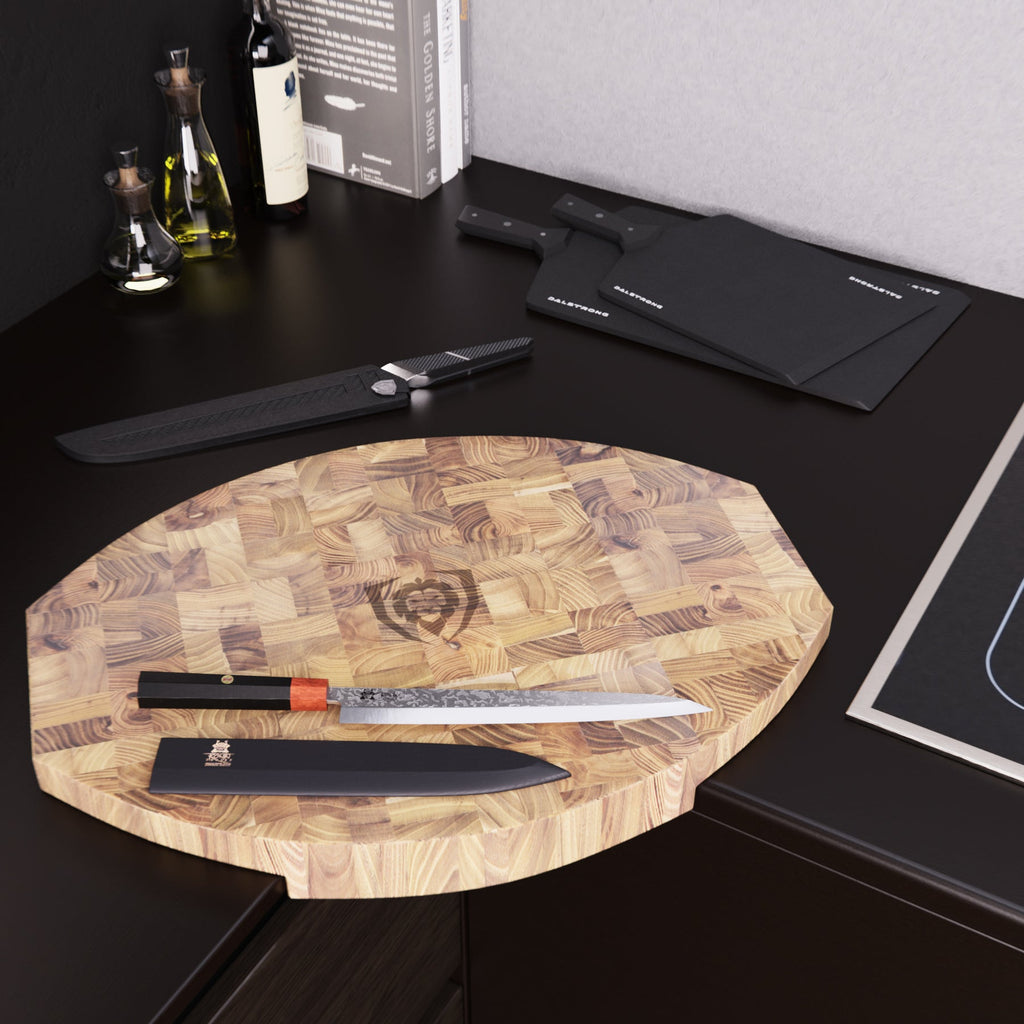
1. What Makes a Good Large Cutting Board?
A cutting board is a single-ply board usually made from wood or plastic or other materials such as marble. They’re also known as butcher blocks, chopping blocks, or just as a ‘board for meat’. A good cutting board would ideally be more than an inch thick for sturdiness and to provide a robust platform for seamless cutting, slicing, chopping, and carving.
If your tiny, plastic board does not offer a comfortable hand grip or a stable surface for food prep, it’s time to invest in large wood cutting boards that will work for you.
2. Why You Should Choose Large Cutting Boards
Safety
There’s nothing worse than a crowded and congested prep station. If you don’t have an ample amount of space, chances are, you’re going to hurt yourself. The first step to preventing mishaps and accidents is by keeping your board perfectly clean and organized. A wooden board also ensures that you don’t go around chasing food all over the kitchen counter. Having everything you need right in front of you makes cooking seem like a breeze.
Cutting and Carving
If you’re big on carving large briskets, roasts, or just meat and fish in general, there is nothing better than a large wood cutting board. It makes the perfect board for meat and also when you want to put together a quick charcuterie board. You can slice, cut, and carve right on your wood cutting board.
Presentation
A large cutting board makes a beautiful surface for presenting appetizers like cheese boards, or main courses like a beautiful roast. The Lionswood Colossal Teak board has elegant steel handles to make transporting and displaying your creations easy and comfortable.
Multiple Uses
Chopping boards can help your culinary tasks in several ways. Large cutting boards, especially those made with Teak wood are easy to clean, and NSF certified, too. Apart from the aesthetic purpose large wooden boards serve, if you’ve got a compact kitchen or cooking space, they fit perfectly over the sink. And hey, if you’re ever running out of space on the kitchen counter, you can always rely on large teak cutting boards – They’re durable, impervious to heat and bacteria, and extremely stable.
Prevention of cross-contamination and other diseases
A large cutting board could save you from diseases like Salmonella. Now, no one wants to double over and fall sick after a delectable meal. I’ve used black plastic cutting boards, and they can get slimy, wet, and slippery quite easily. Not only is that a safety hazard, but it also spreads bacteria and germs around easily.
Wood cutting boards are infused with mineral oils that trap harmful germs and bacteria, which causes them to die. Also, knife scars get created quite easily on plastic cutting boards – Another way they can harbor and spread bacteria. Wood cutting boards are much less susceptible to scars, especially ones created with end-grain wood, like this Lionswood one.
Researchers have spoken about plastic cutting boards and their disadvantages.
Plastic chopping boards don’t get rid of bacteria after being placed in the dishwasher. You have to hand wash them and then put them in the dishwasher once again. With wood chopping boards, that’s one less thing to worry about. There is simply no need for a hustle and hassle.
Wooden boards, especially those made with Teak can stand up to your favorite knives while also resisting water. While this may not seem like a big advantage, it actually is. If your chopping board absorbs water, it is going to swell up and break into chunky bits and pieces. Wooden boards are also more durable and budget-friendly than plastic boards.
3. What To Look For When Buying Large Cutting Boards
Material
The material of your kitchen cutting board matters. Choosing sustainable materials like Teak wood is a great place to start. It has naturally hygienic traits and the wood grain helps maintain your knife’s edge and precision. Wood grain ensures a life-long hygienic cutting surface.
This also makes it ideal for busy and wet environments/kitchens. Teak wood cutting boards are easily clean and stored. It makes the perfect base for wooden cutting boards as it is sturdy enough to offer uniform, clean, and precise cuts. Cutting boards made with Teak wood have mineral oils infused for durability.
Size
While cutting boards come in various sizes, a large cutting board protects your hands when cutting, as it takes up more space on your kitchen counter and will not slip or slide.
The recommended size for a large cutting board runs from 12” x 18” inches to 24” x 36” inches. Wooden chopping boards are also thicker than plastic boards, meeting ergonomic standards. This is so you won’t have to bend to chop meat, fruits, and vegetables.
Lastly, a large cutting board ensures that you have enough knuckle clearance to make precise and clean cuts on the food, which isn’t something you can expect when using a small cutting board.
If you want to read more about the attributes that make a great cutting board, we’ve got you covered here.
4. Types Of Cutting Boards
In this section, we’re going to talk about a wood cutting board, wood carving board, and a butcher’s block chopping board.
Wood Cutting Board
Wood cutting boards, particularly the larger ones are perfect for chopping vegetables, slicing bread, and coring tomatoes. Generally, a large chopping board would be made with Teak wood for maximum durability, as this material is one that is impervious to bacteria.
In terms of thickness, they can be an inch to three inches thick. This gives your board weight as well, which helps cut large briskets, debone fish, or slice and peel vegetables. If you’re working with watery fruits and vegetables, the deep juice groove in large cutting boards will be incredibly useful.
Wood Carving Board
Wood carving boards are often a hybrid of cutting boards and can be used for making charcuterie boards. These are made with premium quality Teak wood to keep bacteria and germs from seeping into it.
Butcher’s Block Chopping Board
Butcher’s block chopping boards can be made with a variety of materials, such as Teak, Oak, Maple, Birch, or Walnut. Undoubtedly, Teak is of the highest quality and is durable like no other wood. Not only is it a great material for chopping boards, it also adds the element of a heavy weighted butcher’s block.
In a nutshell, large butcher’s block chopping boards stop the spread of germs to countertops and prevent slipping of the board. With Teak wood, large cutting boards don’t require a damp paper towel under them. The weight and quality of the wooden board will be enough to keep the board stable.
Plastic Cutting Boards
You may wonder, is a plastic board better than a wooden cutting board? In comparison, Teak wood carving boards are best because they are porous in nature and trap germs which then transfer to knives, and then to your food. Plastic boards also slide easily, especially if they’re being used in busy kitchens or wet environments.
Not only is that a safety hazard, but also a leading cause of the spread of bacteria like Salmonella. These boards don’t come equipped with a juice groove either, so it’s going to make the prep station worse by causing slips and slides.
The damp paper towel you would need to place under your board will not be enough to keep it steady. Plastic boards are unsustainable and will stain or break easily. So, instead of investing in a cheaply priced plastic chopping board, invest in a large wooden kind that will last you for years.
5. Wooden Cutting Boards vs. Plastic Cutting Boards
Now, let’s talk about the differences between wooden cutting boards and plastic cutting boards. Some of the main concerns with plastic cutting boards are maintenance and sustainability. In fact, there are only selective cutting boards that are NSF certified. Let’s dive deeper into these concerns.
Wooden Cutting Board
Wooden Teak boards are highly durable and are very gentle on your knives. These cutting boards can last for years on end. If the surface is damaged over time, it can be salvaged with sandpaper. Plastic and bamboo are considered hardwoods and can dull the blade of your knife. They’re not the best to maintain the sharp edge of your knife either.
There is a myth about wooden cutting boards absorbing unsanitary liquids, but researchers have clarified this – while they do trap liquids, wood is treated to kill any bacteria and germs inside it. As a matter of fact, this can happen as quickly as 10 minutes after the cooking surface of your cutting board is contaminated.
Lastly, large wooden boards are quite pleasing to the eye. The aesthetic of these boards, especially those made with Teak, is unmatchable. This helps you use your board as a board for meat. You can use large cutting boards as a base for charcuterie boards or serving trays. So, you’re killing two birds with one stone.
Plastic Cutting Board
The only upper hand plastic boards have on teak boards is the price. Even then, plastic cutting boards are not the best culinary investment. While small plastic boards can range for as little as $5, you’re going to get what you pay for. The quality will not be up to the industry standard, and you will often find yourself purchasing a new cutting board.
Plastic boards are also usually not NSF certified. In fact, very few are. Most likely, the cheap plastic board that has intrigued you, may not be safe at all. The surface of a plastic board is also difficult to clean, especially when working with curries and sauces. They tend to hold onto the surface and can only be cleaned with a steel scrubber and hot water. That is a lot of work.
Plastic is an awful material for your blade. It wears down a knife faster than any other material while getting scratched up in return, too. These channels all over your board become a place for bacteria to collect. Lastly, plastic cutting boards are not sustainable for the environment. However, an excellent alternative to it is Teak wood, which Dalstrong sources directly and sustainably from tropical deciduous forests.
6. Why Is Teak the Best Wood for Large Cutting Boards?
There are four incredible types of wood that make excellent cutting boards. (Maple, Teak, Beech, and Walnut).
Teak is the best amongst them. Here’s everything you need to know about it.
Teak
This is grown in parts of Southeast Asia and is the best wood for a cutting board, as it is created for durability. Teak is highly resistant to stains, bacteria, and moisture. It has an edge grain which makes it look absolutely stunning.
Teak also retains mineral oils and lasts longer than other woods such as walnut or maple. It is robust and sturdy, but not so much as to dull the blade of your knives. The dense and coarse nature of this wood makes it an excellent fit for large cutting boards. Here’s some additional insight on cutting board oil.
Teak is also resistant to termites, which is a trait you should always look out for when choosing a large cutting board. It can stand in wet and hot environments without taking on any damage, which makes it perfect for busy kitchens and home cooks. Teak will never lose its color either, as it naturally preserves its oil. This prevents it from decaying or losing its vibrant tinge of brown.
And finally, Teak is incredibly long-lasting. It needs little to no maintenance. There will be no need to polish it either, especially the large cutting boards, as they hold well together, thanks to the end grain.
7. How To Care For Large Cutting Boards
If handled with care, Teak can last for decades on end. You may wonder that it could decay, but that is never the case with Teak wood. These are some of the Dos and Don’ts on how to clean a wooden cutting board.
Dos and Don’ts
- Do wash your teak board by hand.
- Do use a soapy mixture to rinse the teak board.
- Do wipe the entire large board with a paper towel after rinsing it.
- Don’t submerge the cutting board in water, a quick dunk is all it needs.
- Don’t place large cutting boards in the dishwasher as the heat will cause it to warp.
- Don’t use bleach to clean your cutting board.
8. Dalstrong’s Best Large Cutting Boards
If you’re looking for an easy-to-clean Teak board with deep juice grooves, Dalstrong has you covered.
1. Lionswood Colossal Teak Cutting Board
Looking for a prep station that is easy to clean and offers an excellent hand grip? This large Teak board has a satin finish with a steel handle to work as a serving tray. The deep juice grooves make life easier as you don’t have to wipe down the cutting board with a paper towel.
Low in maintenance, this board doubles as a butcher’s block or a chopping block.
Pros:
- This Colossal Teak board makes the perfect cutting board for meat.
- Boards with juice grooves are quite expensive, but at Dalstrong, we offer you premium quality cookware essentials at a budget-friendly price.
Cons:
- Teak is a wood grain, so if you’re on the lookout for another material for large cutting boards, this may not be the best fit.
- If you want it to last a lifetime, your Teak cutting board will need regular care and oiling. A fresh oiling once in a while will enhance the natural beauty and resilience of the wood grain, but not everyone is willing to put in the time.
2. Corner Cutting Board - Teak Wood
If you’re looking for a slightly round cutting board that is large, made with Teak wood, and easy to clean, this is the one for you.
Pros:
- Maximizes small spaces by fitting securely into the corner of your counters.
- This Teak cutting board is quite easy to maintain.
- Makes your prep station cleaner and larger in size.
- The corner blocks on this large cutting board offer a hand grip.
Cons:
- If you’re a novice in the kitchen, the size of this Teak board can feel slightly overwhelming.
- If your counters don't meet at a right-angle corner, you may prefer a rectangular cutting board. I suggest this.
3. Teak Cutting Board - Large Size | Horizontal Grain | Dalstrong

Teak cutting boards are the current trend, thanks to the stunning horizontal grain on large cutting boards. This Teak board is made with sustainably sourced Tropical Teak wood and is everything you need to make precise cuts for vegetables fruits, cheese, and pasta.
Pros:
- This large cutting board is perfect for both home cooks and seasoned chefs as it provides ample space for just about any recipe.
- The wood is firm enough to help you achieve uniform slices without dulling the blade of your knife.
- The measurements and juice traps along the edge are handy additions.
Cons:
- If you’re looking for a medium-sized board for a charcuterie board or to use a serving tray, I would suggest this Teak cutting board.
- This board doesn’t have handles for transporting large loads, which could be inconvenient if you plan to use it to serve.
4. Teak Cutting Board - Medium Size | Dalstrong

This medium size cutting board is all you need for homes that are slightly compact. This Teak board is designed for those that want a cutting board that does not take up a lot of space.
Pros:
- This board is perfect to carry items from the kitchen to the dinner table and vice versa.
- Having a quiet night in? Assemble your very own charcuterie board with this Teak board.
- The built-in measurements are handy references and the juice trap helps keep your kitchen tidy.
Cons:
- Could be slightly small for you if you carve large pieces of meat often.
- This board doesn’t have handles for hand grip which could be inconvenient.
5. 4-Piece Charcuterie & Cheese Knife Set
Looking to assemble a charcuterie board on your Teak board? Then, you need this 4-Piece charcuterie and cheese knife set! The blade is made with wear-resistant German ThyssenKrupp steel that is hardened at 56+ Rockwell. The 3.75” inch forked tip is perfect to pick soft cheeses like feta and mozzarella.
Pros:
- It comes with a variety of 4 cheese knives, which is perfect if you love charcuterie boards or just cheese in general!
- If you’re big on serving cheeses, this knife set is elegant to be set aside on a large cutting board.
Cons:
- If you’re not a huge fan of cheese or laying out a charcuterie board, you may not need this 4-Piece charcuterie and cheese knife set.
- If you’re looking for a one-time cheese board fix, the price may not seem justifiable, especially if you’re on a budget.
9. Frequently Asked Questions
The recommended size for a large cutting board is 12” x 18” inches to 24” x 36” inches.
What is a good size for a cutting board?A cutting board that is 25"x18" inches in size is ideal.
What is the most sanitary type of cutting board?A wooden cutting board is the most sanitary type of cutting board as it is resistant to moisture, water, and bacteria.































































